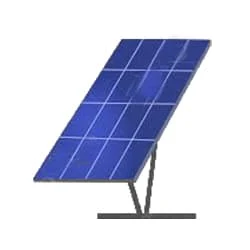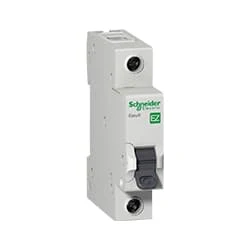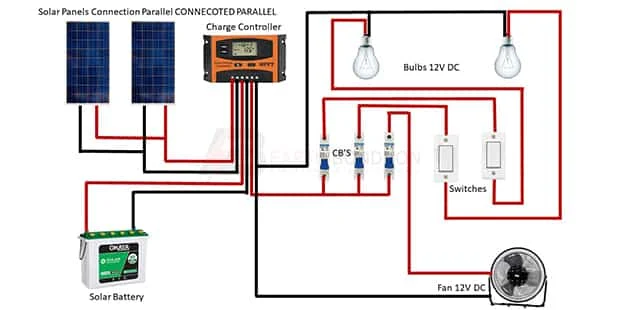Solar Panel Wiring connection In House:
This diagram shows how to make Solar Panel Wiring Connection In House. solar panel wiring diagram. In this circuit, we use two solar panel boards, a solar charge controller, two lights, two SPST ( Single Pole Single Throw Switch), a 12V DC fan, three TP MCB ( Tripple Pole Miniature Circuit Breaker ), and 12V Battery. This circuit is very simple and very easy to make. If you want to know more about this circuit please stay with our website and check our youtube video below the post.
Diagram of solar panel wiring:
Components Need for this Project:
You can get the components from any of the sites below:
- Swtich [See Buy Click Amazon]
- Solar Panel [See Buy Click Amazon]
- Solar charge Controller [See Buy Click Amazon]
- SP MCB [See Buy Click Amazon]
- 12V Battery [See Buy Click Amazon]
- DC Fan [See Buy Click Amazon]
- DC Light [See Buy Click Amazon]
Read Also:
Components used to make the Project_name:
01. Swtich
 |
| Fig 2: Switch |
A Single-Pole, Single-Throw (SPST) Switch. It's Got one Output and One Input. The Switch will Either be Closed or Completely Disconnected. SPSTs are Perfect for on-off Switching. They're also a Very Common Form of Momentary Switches. SPST Switches are Commonly Used in a Variety of Electrical Circuits and Applications, Such as Turning on And off Lights, Fans, and Other Appliances. They can Also be Used to Control the Flow of Electricity to Different Parts of a Circuit or to Switch Between Different Circuits Altogether.
02. Solar Panel
 |
| Fig 3: Solar Panel |
Photovoltaic solar panels can generate electricity directly from sunlight. Photovoltaic (PV) modules are connected assemblies of photovoltaic solar cells available in a package of various voltages and wattages, but not direct sunlight. And the sun also does not transmit electricity directly to the earth. Sends light and heat. It has to convert our electricity in different ways. We get heat energy from the sun very easily. Instead, it transmits light and heat.
03. Solar charge Controller
 |
| Fig 4: Solar charge Controller |
The function of a solar charge controller is to charge the battery by regulating the voltage and current coming from the solar. That is, reduce the voltage slightly so that the battery cell is not damaged due to high voltage. It's called a controller rather than a charger because it's so smart. Automatically provides proper power to the battery according to over voltage, over the current, short circuit, and battery temperature. There are two types of charge controllers. PWM and MPPT, PWM is relatively cheaper but has lower efficiency. On the other hand, good quality MPPTs are very efficient and offer maximum safety to the battery.
04. SP MCB
 |
| Fig 5: SP MCB |
MCB SP means single pole it protects only one phase switching. MCB (Miniature Circuit Breaker) Curswitch is the most basic general-purpose switch that you use to control a light or another device from one location. These Switches Have Two Brass-Colored Screw Terminals Connected to the hot Power Source Wires. (MCB) For any Distribution Board, the Protection System Must be Used in The Incomer. Phase and Neutral Single Phase Supply to break. 120-volt circuits, 15-20 amp single pole breaker is typically used.
05. 12V Battery
 |
| Fig 6: 12V Battery |
A 12-volt Battery is an Irregular Battery used in Specific Electronic Applications. Of all the types of Batteries, the 12-Volt Battery is one That Looks Very Different Depending on its use. It can be Large or small, Heavy or Light. Twelve-volt batteries are commonly used in RV, Boat, and Other Automobiles Systems. From a Technical Perspective, a Battery Uses one or more cells to Allow a Chemical Reaction Creating the flow of Electrons in a Circuit.
06. DC Fan
 |
| Fig 7: DC Fan |
12V DC cooling fan 2 inches 50mm, The direct current fans, or DC fans, are powered With a potential of Fixed value Such as the voltage Of a battery. It Features maintenance-Free double ball long Service Life, Bearings, Sufficient Heat Dissipation Air Volume, and air pressure. Normally the electricity we use at home is AC and the output of the IPS is AC though it accepts battery (DC) supply during load shedding. If you can't do it yourself, make a bridge rectifier and connect it to the motor (fan) using a 16-volt 100mf electrolytic capacitor. Low fan speed can be caused by an overload of the IPS power you use or a weak capacitor on your fan.
07. DC Light
 |
| Fig 8: DC Light |
LED (light emitting diode) is basically a type of diode that emits light at a certain voltage. These LED bulbs turn on at a very low voltage such as 2~3 volts. When the light emitting diode is forward biased, the free electrons in the n-type semiconductor gain electrical energy from the DC source and move from the balance band to the conduction band and the electrical Under the influence of pressure, current flows through the junction to P-type. In the p-type majority of carrier holes are located in the valence band. Thus basically the p-n junction becomes a light source.
Thank You for visiting the website. Keep visiting for more Updates.


Post a Comment
Do leave your comments